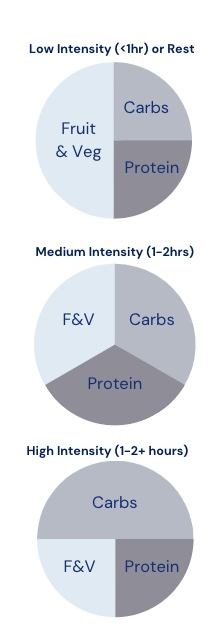How to Build a Performance Plate
NUTRITION COACHING AND MEAL PLANNING FROM YOUR REGISTERED DIETITIAN NUTRITIONIST HERE IN BOSTON’S BACK BAY
If you’ve got your marathon gel timing and post-lift protein shake down but aren’t sure what to eat for your main meals, this post is for you. As an athlete, your energy needs change depending on how hard and for how long you train. Here, we’ll do a quick review of the macronutrients - the 3 essential nutrients that supply our bodies with energy - and how you can eyeball mealtime needs without counting, measuring, or tracking every bite.
First, you should get the detailed Fuel & Hydration Guide that accompanies this post:
Carbohydrates
Carbs are the body’s main source of energy. They fuel your brain, muscles, and red blood cells. Whether living everyday life or training, you need carbs! Hell, the brain alone uses about 130g of carbohydrate per day. Makes you think twice about keto, doesn’t it?
One serving of carbohydrates is about:
1/2 cup cooked grains (rice, quinoa, etc.)
1/2 cup cooked pasta
1 slice of bread
1 cup of cereal
1 medium potato
1 cup cooked starchy vegetables
Examples of performance plates by carbs, protein, and color.
This is the macronutrient that most needs to be adjusted depending on training intensity and duration. As training increases, intake of carbs should also increase! When you use the performance plate guide, your carbs will range from 1 to 2 servings per meal, or from 1/4 to 1/2 the plate (see right):
Light days or rest: 1 serving / quarter plate
Moderate training days (1-2hrs): 1.5 servings / third plate
Heavy training days (1-2+ hours): 2 servings / half plate if not more
Protein
Protein supplies the building blocks for muscle growth & repair and for structures like nails & bones. Protein is also important for satiety, meaning that without protein, you won’t feel full or satisfied after eating. (Tip: If you’re hungry after eating, add protein.)
Protein intake should be no less than 0.8g protein/kg of body weight per day, with most athletes needing 1.5g-2.0g/kg per day. Without doing math, you can aim for 20-30g of protein per meal, which will mostly stay constant at 1/4 to 1/3 of the plate depending on your needs.
Fat
Fats are what fuel low-intensity work and longer durations of training. We also need fats for satiety and functions like hormones, nerves, and nutrient absorption. Here, we want to prioritize healthy unsaturated fats - the kind from nuts, seeds, avocados, and olive oil.
Fat can be considered an accessory, since it’s often found accompanying other foods (like salmon) or added to a dish while cooking. To help balance overall energy needs, aim for fats to be:
Light days or rest: 1 tablespoon
Moderate training days (1-2hrs): 1.5 tablespoons
Heavy training days (1-2+ hours): 2 tablespoons
Color
Here’s a trick! Not a macronutrient, but fruit and vegetables should make up a major component of your daily intake. This is where you’re getting the vitamins and minerals - the micronutrients - your body needs to function optimally. Aim for:
Light days or rest: 2 cups/handfuls / half the plate
Moderate training days (1-2hrs): 1.5 cups/handfuls / third of the plate
Heavy training days (1-2+ hours): 1 cup/ handful / quarter of the plate
Putting It All Together
Using the details and visual guide, I challenge you to adjust your next meal to meet your training needs. My Fuel & Hydration Guide takes this 1 step further and includes foods by category, a timeline for fueling around exercise, and a 1-page hydration timeline, too.
Still looking for more guidance? Let’s personalize this for you in in 1:1 nutrition counseling or with flexible meal planning. Schedule your 15-min discovery call here.

